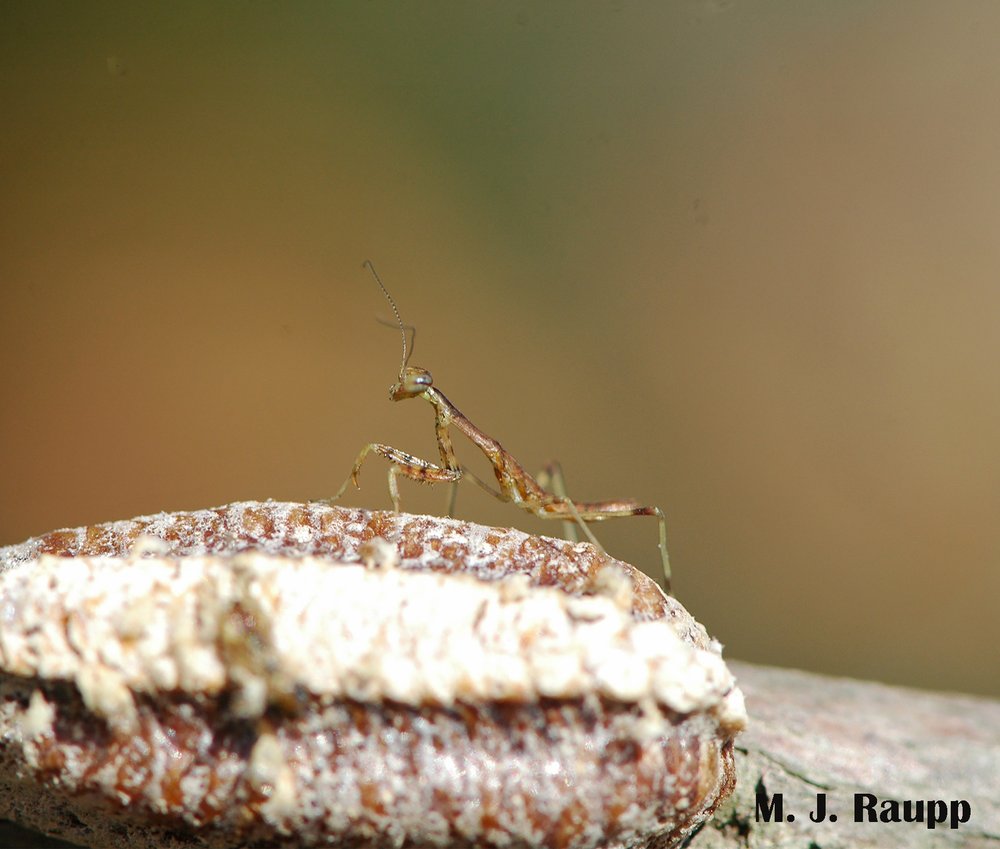
A gorgeous Carolina mantis named Dot enjoys an early Thanksgiving feast of spotted lanternfly.
Last week we learned that subfreezing temperatures in the DMV were bringing an end to mischief caused by spotted lanternflies. However, Mother Nature’s chill is not the only thing putting a beat-down on this pest. Early in the invasion of spotted lanternfly in the US we read things like this, “…as with many other insects arriving to the United States from other parts of the world and finding no established natural enemies here, it has become very invasive.” Back then, it seemed like there might be no stopping these grape-killing, honeydew-squirting rascals, but now we know better.

After emerging from an egg case called an ootheca, a tiny Carolina mantis takes its first glimpse of a world full of wonderful morsels to eat. Hopefully, many of these meals will be spotted lanternflies.
A recent publication by scientists at Penn State University summarized observations of acts of predation on various life stages of spotted lanternfly. Arthropods led the carnage with more than 200 attacks by spiders, 196 attacks by mantids, 177 attacks by wasps, 55 attacks by sucking predators like assassin bugs, and another 21 attacks by other arthropods. Twenty some families of birds accounted for more than 500 attacks, with ground dwellers like chickens and pheasants leading the way. Death delivered by members of the cardinal, mocking bird, wren and several other bird clans contributed to the total. Mammals, amphibians, fish and non-feathered reptiles also got into the act accounting for 106 additional observations. Wow! So, when my grandson spotted a Carolina mantis on the window last week, well, we named her Dot (guess why) and just had to invite her in for an early Thanksgiving feast of spotted lanternfly.
The Carolina mantis ranges from southern Canada into Central and South America. Like other mantis species, Carolina mantises eat a wide variety of insects and spiders found in gardens and landscapes. And yes, on occasion the female consumes her unfortunate mate, especially when mantises are raised in captivity. The extent to which this is an artifact of being raised under unnatural conditions is not known, but it is reported that well fed gals are less likely to consume their suitors than hungry ones. We welcomed Dot into our home and noticed that she was rather pregnant and that she appeared to need just a few more meals to finish the job of generating a full complement of eggs. When placed in a small terrarium housing a half dozen lanternflies, she wasted no time mounting an attack. We have all seen those wildlife movies where a cheetah jets after a gazelle but eventually fails in its attack. Well, Dot’s first try on a lanternfly failed when she brushed the lanternfly with her leg and it sprang away. Not one to give up, her second attack scored. Having witnessed other acts of mantis predation, I was not surprised to see her start at the head and work her way down the body to the meatier parts.
Meet Dot, a Carolina mantis that stopped by for an early Thanksgiving feast. We offered her some lanternflies but her first attempt to capture one didn’t go that well. With a little more stealth and a faster strike she scored on the second try. Apparently, the first place to start on a lanternfly dinner is the head just behind the left compound eye. After dinner and before the next escapade, it’s always good to do a little grooming. She reminds me of a cat when she does this. Below the dinner place we can see that not much is left of the lanternfly when she is done. After the feast she returned to the wild to continue her beneficial work.
Our house guest dined for a few days devouring a lanternfly or two each day before we released her in a grove of lanternfly infested trees. Here’s hoping her Thanksgiving feast of lanternflies continues long enough for her to lay a mass of eggs before chilly weather closes the door on her escapades. No doubt her legacy of tiny mantis offspring will help mitigate the mischief caused by spotted lanternflies in 2024.
Acknowledgements
Bug of the Week thanks eagle-eyed Jackie for spotting the hungry Carolina mantis that was the heroine of this episode. The wonderful article “Using community science to identify predators of spotted lanternfly, Lycorma delicatula (Hemiptera: Fulgoridae), in North America” by Anne E. Johnson, Alison Cornell, Sara Hermann, Fang Zhu and Kelli Hoover was used to prepare this story.
No comments:
Post a Comment